Tissues
NCERT-CBSE-Class-9-Science-Chapter-6
Notes
|
Topics to be learn : Plant Tissues :
Animal Tissues :
|
Tissues :
- A tissue is formed by a group of cells similar in structure and working together to achieve a particular function.
- Tissues are specialized cells that perform specific functions efficiently, such as movement, communication, and transportation.
- In humans, muscle cells cause movement, nerve cells carry messages, and blood flows to transport oxygen, food, hormones, and waste material. In plants, vascular tissues conduct food and water.
- Multi-cellular organisms show division of labor, with cells specialized in one function often grouped together in the body. These tissues, such as blood, phloem, and muscle, are designed to give the highest possible efficiency of function.
Are Plants and Animals Made of Same Types of Tissues? :
- The structural and functional organisations are different in both plants and
- animals, i.e. plants are stationary and have a large quantity of supportive tissue, mostly dead cells. Animals move around, consume more energy, and contain most tissues that are living.
- Plant growth is limited to certain regions, while animal growth is more uniform.
Animals have more specialized and localized organ structures and systems. - This difference reflects different modes of life pursued by these two groups, particularly in their feeding methods.
- Animals are adapted for sedentary existence, while plants are adapted for active locomotion.
- Based on these habits, the tissues in plants and animals are strikingly different. So, tissues are further classified as plant tissue and animal tissue.
Plant Tissues :
On the basis of dividing capacity, plant tissues can be classified into two fundamental types as follows :
(i) Meristematic Tissue : The tissues in which cells always divide and give rise to new cells are called meristematic tissues.
- The growth in plants occurs only in those regions where meristematic tissues are present, e.g. root and shoot tip.
- Hence, meristematic tissue is also called dividing tissue due to its actively dividing property.
Characteristics of meristematic tissue :
- Cells of this tissue are very active.
- They have dense cytoplasm and thin cellulosic walls.
- They have prominent nuclei.
- Cells of this tissue lack vacuoles.
The characteristics of meristematic tissue changes once they grow and become differentiated as component of other tissues.
Types of Meristematic Tissue :
On the basis of region where they are present in plant, meristematic tissues are of following types
(i) Apical meristem : It is present at the growing tips of stems and roots. It is helpful in increasing the length of the stems and the roots.
(ii) Intercalary meristem : It is present at the base of the leaves or internodes (on either side of the node). It helps in the longitudinal growth (elongation) of plants.
(iii) Lateral meristem (Cambium) : It is present on the lateral sides of stems and roots. It helps in increasing the girth of the stem and the root.
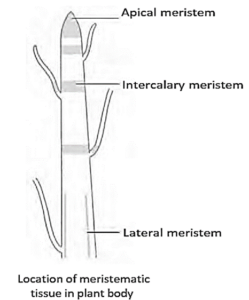
Permanent Tissue :
These tissues are formed from the cells of meristematic tissue when they loose their ability to divide. This process of taking up a permanent shape, size and function is called differentiation.
As a result of differentiation, the meristematic tissues tend to form different types of permanent tissues. These are as follows
(1) Simple Permanent Tissue :
It is made up of only one type of cells, i.e. the cells forming these tissues are similar in structure and function. These are mainly found beneath the epidermis. The simple permanent tissue can be either supportive or protective in function.
This tissue is further classified into three types, which are as follows :
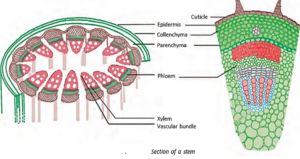
(i) Parenchyma : It is the most common simple permanent tissue. These are present in the soft parts of the plant like leaves, roots, fruits, flowers, etc.
- It consists of simple living cells with little or no specialization and thin cell walls. The cells are usually loosely packed with large spaces between them (intercellular spaces).
Functions :
- Parenchyma serves as a food storage tissue.
- In some situations, parenchyma cell contains chlorophyll and performs photosynthesis. Such type of tissue is called chlorenchyma.
- In aquatic plants, large air cavities are present in parenchyma cells in order to give buoyancy to plants, which help them to float. Such type of parenchyma tissue is called aerenchyma.
- Parenchyma of stems and roots also stores nutrients and water.
(ii) Collenchyma : These tissues are generally found in leaf stalks below the epidermis.
- Cells of this tissue are living, elongated and irregularly thickened at the corners. These have very little intercellular spaces.
Functions :
- Collenchyma provides mechanical support and flexibility to plants.
- It also allows easy bending in various parts of a plant (tendrils and stems of climbers) without breaking.
(iii) Sclerenchyma : It is present in stems, around vascular bundles, in the veins of leaves and in the hard covering of seeds and nuts.
- The cells of sclerenchymatous tissue are dead, long and narrow in appearance. Cell walls are thickened due to lignin (a chemical substance) deposition.
- Due to the presence of thick walls, there is no internal space between the cells.
Functions :
- It provides mechanical strength to the plant parts.
- It makes the plant hard and stiff. For example, husk of coconut is made up of sclerenchymatous tissue.
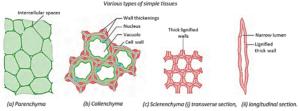
Protective Permanent Tissues : These tissues cover the surface of roots, stems and leaves. They mainly includes epidermis and cork.
(i) Epidermis : It forms the outermost layer of plant body and is made by single layer of cells.
- Cells of epidermal tissue form a continuous layer.
- They have no intercellular spaces.
- Most epidermal cells are relatively flat.
- Their outer wall and side walls are thicker than the inner wall.
- Epidermal cells of leaf bear small pores known as stomata. These are enclosed by two kidney-shaped cells called guard cells.
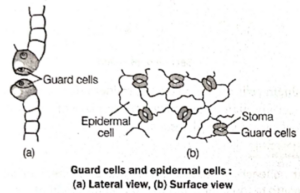
Functions :
- Epidermal cells in plants secrete waxy, water-resistant layers on their aerial parts to protect against mechanical injury and parasitic fungi invasion.
- Desert plants have thick waxy cutin coatings to minimize water loss.
- Root cells have long hair-like parts, increasing absorptive surface area.
- Stomata aid in gas exchange and transpiration, reducing water loss through water vapor.
- These functions ensure plant health and function.
(ii) Cork : It is the strip of secondary meristem, located in the cortex, forming a layer of cell which constitute the cork.
- Cells of cork are dead, compactly arranged and have no intercellular spaces.
- It possess a substance called suberin in the walls to makes them impervious to gases and water.
- It also protects the plant from mechanical injury.
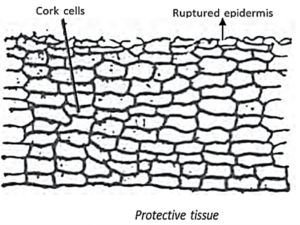
(2) Complex Permanent Tissue :
These tissues are made up of more than one type of cells.
All these cells present in a tissue coordinate to perform a common function.
There are two types of complex permanent tissue, i.e. xylem and phloem.
Both of them are conducting tissues and constitute to form a vascular bundle. This is a distinctive feature of complex plants. It has made possible their survival in the terrestrial environment.
(i) Xylem : It is a type of conducting tissue responsible for the transport of water and minerals from roots to other parts of the plant. Xylem consists of four different types of elements, which are as follows
- Tracheids : These are dead, long, tubular structures with tapering ends. They transport water and minerals vertically.
- Vessels : These are also dead, long and tube-like structures that helps in the vertical conduction of water.
- Xylem parenchyma : These are the only living cells of xylem with thin cell walls. They store food and help in the sideways conduction of water.
- Xylem fibres : They have elongated dead cells with tapering end and thick cell walls. These are mainly supportive in function.

(ii) Phloem :
It transports food from leaves to other parts of the plant. Majorly phloem is made up of following four types of elements
- Sieve tubes : These are tubular cells with perforated walls. They have thin layer of cytoplasm. They help in the transport of formed food to storage organs.
- Companion cells : These are small elongated cells having thin walls. The cells help sieve tubes in translocation of food.
- Phloem fibres : These are thick walled sclerenchyma cells which provide mechanical strength to the tissue.
- Phloem parenchyma :These are thin-walled cells which help in storage of food.
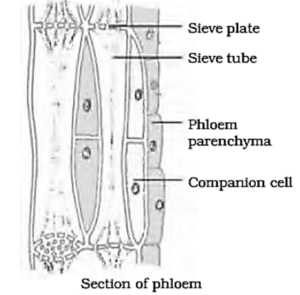
All phloem cells are living except phloem fibres. In hilly areas, certain plants have sieve cells in place of sieve tubes. Sieve cells lacks sieve plates.
Animal Tissues :
Animal tissues are groups of similar cells that work together to perform specific functions in the body.
Types of Animal Tissues :
There are four main types of animal tissues: epithelial, connective, muscular, and nervous tissue.
(1) Epithelial Tissue :
- It is the simplest covering or protective tissue of the animal body. This tissue covers most organs and cavities within the body.
- It also forms a barrier to keep different body systems separated from each other.
Important characteristics of epithelial tissue :
- In this tissue, cells are tightly packed and form a continuous sheet.
- There is almost no intercellular space between them.
- They have a very small amount of cementing material between them.
- The epithelium is separated from underlying tissue by an extracellular fibrous basement membrane.
- The skin, lining of mouth, lining of blood vessels, alveoli and kidney tubules, all are made up of epithelial tissue.
Classification Of Epithelial Tissues :
On the basis of shape of the cells and their arrangement, epithelial tissues are further classified as follows :
(i) Squamous Epithelium : Squamous (Squama means scale) is made up of simple flat kind of cells. It is further categorised into two types
(a) Simple Squamous Epithelium :
- It is single-layered and closely fitted epithelium. The cells are very thin and flat and appear as tiles over the floor.
- It forms a delicate lining of blood vessels and lung alveoli, where substance transport occurs through a selectively permeable membrane.
- It also covers the oesophagus and the lining of mouth and the lining of blood vessels.
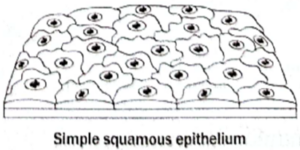
(b) Stratified Squamous Epithelium :
- Cells are arranged in the pattern of many layers to prevent wear and tear.
- It is found in the outer side of skin as it is highly resistant to mechanical injury.
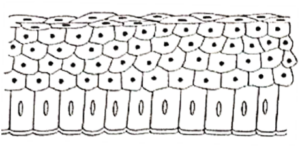
(ii) Cuboidal Epithelium :
- It is made up of cube-shaped cells.
- It forms the lining of kidney tubules and the ducts of salivary glands, where it provides mechanical support.

(iii) Columnar Epithelium :
- Columnar (columnar means pillar-like) epithelium is made up of tall, pillar-like cells.
- It usually lines the surfaces where absorption and secretion occur. For example, inner lining of intestine.
- It facilitates the movement across epithelial barrier.
(iv) Ciliated Columnar Epithelium :
- When columnar epithelial cells possess cilia (hair-like projections) on its outer surface, it is called ciliated columnar epithelium.
- It is found in the respiratory tract and also lines oviducts, sperm ducts, etc.
- The cilia have the ability to move. Their movement pushes substances like mucus forward to clear it.
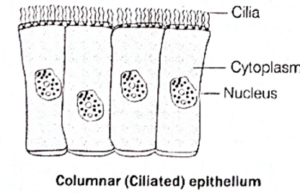
(v) Glandular Epithelium :
- It is a modified columnar epithelium. Its cells are modified to secrete chemical substances at the epithelial surface.
- Sometimes, portion of the epithelial tissue folds inwards and as a result the formation of a multicellular gland occurs.
Functions of Epithelial Tissue
- It protects the underlying cells from drying, injury, infections and from the harmful effects of chemicals.
- It plays a vital role in regulating the exchange of materials between the body and the external environment and between different body parts.
- It helps in absorption of water and nutrients and in diffusion of gases.
- It helps in the elimination of waste products from the body.
(2) Connective Tissue :
Connective tissue is a type of animal tissue that supports, binds, and connects different parts of the body. It is made up of cells, fibers, and an extracellular matrix that provides strength and flexibility.
Characteristics of connective tissue :
- The cells of connective tissue are loosely packed.
- These cells are living and are found embedded in an intercellular matrix that may either be jelly-like fluid, dense or rigid in nature.
- The nature of matrix differs in concordance with the function of the particular connective tissue.
Various types of connective tissues :
(i) Blood :
- It is a fluid connective tissue that links different parts of the body.
- It contains fluid (liquid) matrix called plasma in which RBCs (Red Blood Corpuscles), WBCs (White Blood Corpuscles) and platelets are suspended. Plasma also contains proteins, salts and hormones.
- Blood flow transports nutrients, gases, digested food, waste material, hormones and vitamins to various tissues of the body. It also conducts heat and regulates body temperature.
- The properties shown by different blood cells in the body are as follows
- RBCs help in transport of respiratory gases, oxygen and carbon dioxide with the help of haemoglobin to and from the various parts of our body. The average lifespan of RBCs is about 120 days.
- WBCs help to fight with diseases by producing antibodies.
- Blood platelets help in the clotting of blood.
Different types of blood cells are shown below
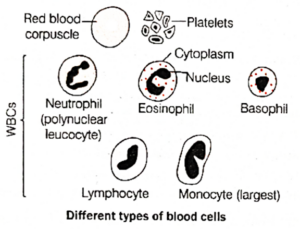
(ii) Bone :
- It is another example of a connective tissue.
- It is very strong and non-flexible tissue. Bone cells are embedded in a hard matrix that is composed of calcium and phosphorus compounds.
- It forms the framework that supports the body.
- It also anchors the muscles and supports the main organs.
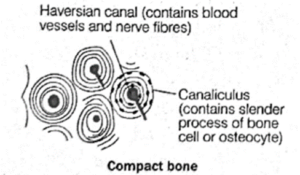
(iii) Ligaments :
- Two bones can be connected to each other by another type of connective tissue called ligament.
- A ligament is very elastic and has considerable strength.
- It contains very little matrix.
- Ligaments strengthen the joints and permit normal movement. Their overstretching may lead to sprain.
(iv) Tendons :
- These are strong and inelastic structures, which join skeletal muscles to bones.
- These are composed of white fibrous tissues with limited flexibility, but has great strength.
(v) Cartilage :
- It is a specialised connective tissue having widely spaced cells.
- It has solid matrix which is composed of proteins and sugars.
- It is present in nose, ear, trachea and larynx.
- Cartilage provides smoothness to the bone surfaces at the joints.
- It also provides support and flexibility to body parts.

(vi) Areolar Tissue :
- It is a supporting and packing tissue found between the organs lying in the body cavity.
- It is located between skin and muscles, around blood vessels and nerves and in the bone marrow.
- It fills the space inside the organs, supports internal organs and helps in the repair of tissues.
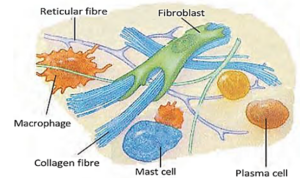
(vii) Adipose Tissue :
- It is located below the skin and in between the internal organs.
- Adipose tissue, commonly known as body fat, is a specialized connective tissue that stores energy in the form of fat. Thus, cells of this tissue are filled with fat globules.
- It acts as an insulator due to the storage of fats and provides cushioning for the body.
- It plays a crucial role in metabolism, and hormone regulation.
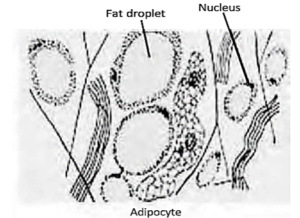
(3) Muscular Tissue :
- Muscular tissue is a specialized tissue responsible for movement, support, and heat production in the body.
- It is made up of muscle fibers (cells) that have the ability to contract and relax. It contains special type of proteins called contractile proteins, which causes movement of muscles by contraction and relaxation.
Types of muscular tissues :
(i) Striated Muscles
- Under microscope, these muscles show alternate light and dark bands or striations (striped appearance). Thus, these are known as striated muscles.
- Mostly these are attached to bones via tendons.
- It is responsible for voluntary movements like walking, running etc.g. muscles of limbs. Hence, these are also called as skeletal muscles.
- The cells of such muscles are long, cylindrical, unbranched and multinucleated (having many nuclei).
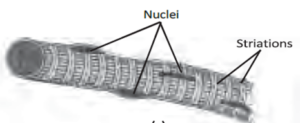
(ii) Smooth Muscles :
- Smooth muscles do not have any dark or light bands. These are also known as unstriated muscles.
- These muscles are called involuntary because they do not move voluntarily.
- Involuntary motions include food movement in the digestive system and blood vessel contraction and relaxation.
- Smooth muscles may be found in several parts of the body, including the iris, ureters, and bronchi.
- These muscles are made up of long, spindle-shaped cells with a single nucleus.
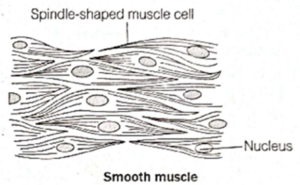
(iii) Cardiac Muscles :
- These are involuntary muscles present only in our heart.
- These muscles perform rhythmic contraction and relaxation throughout the life.
- The cells constituting cardiac muscles are cylindrical, uninucleate and branched.
- Cardiac muscles have stripes of light and dark bands.

(4) Nervous Tissue :
The tissue that receives stimulus and transmits it from one part of the tissue to other is called nervous tissues.
The cells that constitute nervous tissue are called nerve cells or neurons.
These are highly specialised for receiving stimulus and then transmitting it very rapidly from one place to another within the body itself. Brain, spinal cord and nerves are composed of nervous tissue.
An individual nerve cell or a neuron may be upto a metre long and is composed of three major parts
- Cell body : It consists of cytoplasm and nucleus.
- Axon : It is a single long conducting fibre extending from cell body. It transmits impulses away from the cell body.
- Dendrites : These are short branched fibres of neuron, which receive nerve impulses.
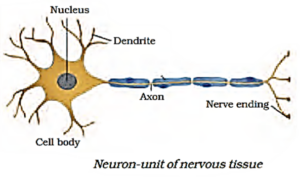
- Many nerve fibres bound together by connective tissue made up of a nerve.
- The signal that passes along the nerve fibre is called nerve impulse.
- It allows us to move our muscles according to our will.
- Combination of nerve and muscle tissue in animals is of fundamental importance as it causes rapid movement in response to stimuli.
Differences between Plant Tissues and Animal Tissues :
| Plant Tissues | Animal Tissues |
| Plants have more abundant dead supporting tissues than live ones | Living tissues are more frequently found than dead tissues in multicellular creatures. |
| They require less maintenance energy due to their autotrophic nature and ability to produce their own food. | They require more maintenance energy as they are heterotrophic and have to move in search of food. |
| These tissues are differentiated into meristematic and permanent tissues, which are localized based on their dividing capacity. | Such differentiation is absent in animals as their growth is uniform. |
| Meristematic tissue allows plants to continue growing throughout their life. | Animals do not show growth after reaching maturity. Reparative growth is however, present. |
| The organization of plant tissues is simple and designed for stationary habits. | Animal tissue organization is intricate, involving the development of specialized and localized organs and systems, aimed at enhancing animal mobility. |
Click on below link to get PDF from store :
PDF : NCERT-Class-9-Science-Chapter-6-Tissues - Notes
PDF : NCERT-Class-9-Science-Chapter-6-Tissues - Solution
Main Page : NCERT-Class-9-Science – All chapters notes, solutions, videos, test, pdf.
Previous Chapter : Chapter-5-THE FUNDAMENTAL UNIT OF LIFE – Online Notes
Next Chapter : Chapter-7- MOTION – Online Notes
